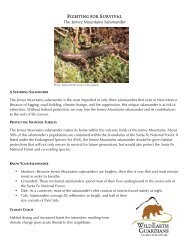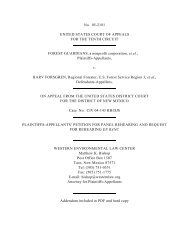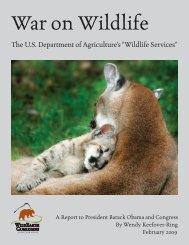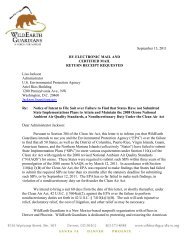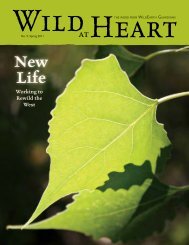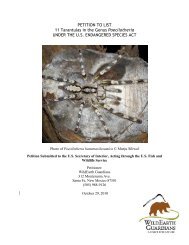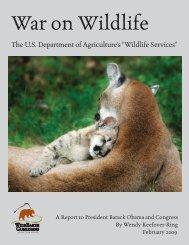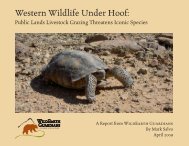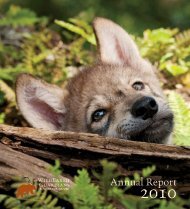PETITION TO LIST THE JEMEZ MOUNTAINS SALAMANDER ...
PETITION TO LIST THE JEMEZ MOUNTAINS SALAMANDER ...
PETITION TO LIST THE JEMEZ MOUNTAINS SALAMANDER ...
You also want an ePaper? Increase the reach of your titles
YUMPU automatically turns print PDFs into web optimized ePapers that Google loves.
WildEarth Guardians Petition to List<br />
Jemez Mountains Salamander Under the ESA<br />
11<br />
preference for areas with high densities of large fir and all size classes of spruce<br />
(Ramotnik and Scott 1988a).<br />
The Jemez Mountains salamander prefers steep slopes at elevations above 7,200 feet<br />
(2200 – 2900 m) within loose rocky soils (Ramotnik and Scott 1988a; Degenhardt et al.<br />
1996). Old, stabilized talus slopes are an important type of cover for this species,<br />
especially those with a good covering of damp soil and plant debris (NMDGF 1988;<br />
Ramotnik and Scott 1988a). Salamanders are difficult to find on south-facing slopes,<br />
and a steep slope is one of the most useful variables in determining the occurrence of this<br />
salamander (Ramotnik and Scott 1988a). It is thought that the soils of steep slopes<br />
contain more interstitial spaces than do shallower slopes. These soils may be less<br />
compacted than those of more gentle slopes due to the combined effects of gravity and<br />
movement of water and soil. As a consequence of a steep slope and the underlying<br />
volcanic rock, characteristic of the Jemez Mountains, are spaces within the matrix of<br />
rocky soil. These spaces may provide refugia for salamanders during inhospitable times<br />
(Ramotnik and Scott 1988a).<br />
In these habitats, salamanders spend much of their time below the surface, including<br />
under rocks and in fallen logs. Salamanders are rarely observed on the surface. When it<br />
is observed it is encountered under bark, surface litter, or logs. Ramotnik and Scott<br />
(1988a) observed 96% of salamanders as occurring among coarse woody debris (68%),<br />
rocks (27%), and fine woody debris (1%). The difficulties in traversing the terrain<br />
salamanders inhabit along with the low probability of sighting salamanders at the surface<br />
make this a difficult species to monitor.<br />
Behavior<br />
The Jemez Mountains salamander spends the majority of its life underground and is<br />
nocturnal. Like all plethodontids, this salamander lacks lungs and instead obtains oxygen<br />
directly through mucous membranes of the mouth and throat and through its skin. The<br />
skin is very thin and must be moist for respiration to occur. Surface activity depends on<br />
favorable air temperatures and moisture, as desiccation is quickly fatal. Although P.<br />
neomexicanus rarely leaves the shelter of rotted logs or rocks it can travel short distances<br />
overland in darkness with the presence of sufficient moisture (Degenhardt et al. 1996).<br />
Daily and seasonal activity patterns of the Jemez Mountains salamander are primarily<br />
governed by temperature and moisture (Ramotnik and Scott 1988a). The thermal<br />
preferendum of this species is 12.4°C (54.3°F) (NMDGF 2004). As poikilothermic<br />
animals, with no control over their body temperatures except possibly through behavioral<br />
means, the salamander’s body temperature varies with the temperature of the immediate<br />
environment. Individuals will retreat underground during dry periods and will be active<br />
on the surface only on wet nights (Carey 1987). The critical thermal maximum for this<br />
species is 33.5°C (92.3°F) (Whitford 1968).



